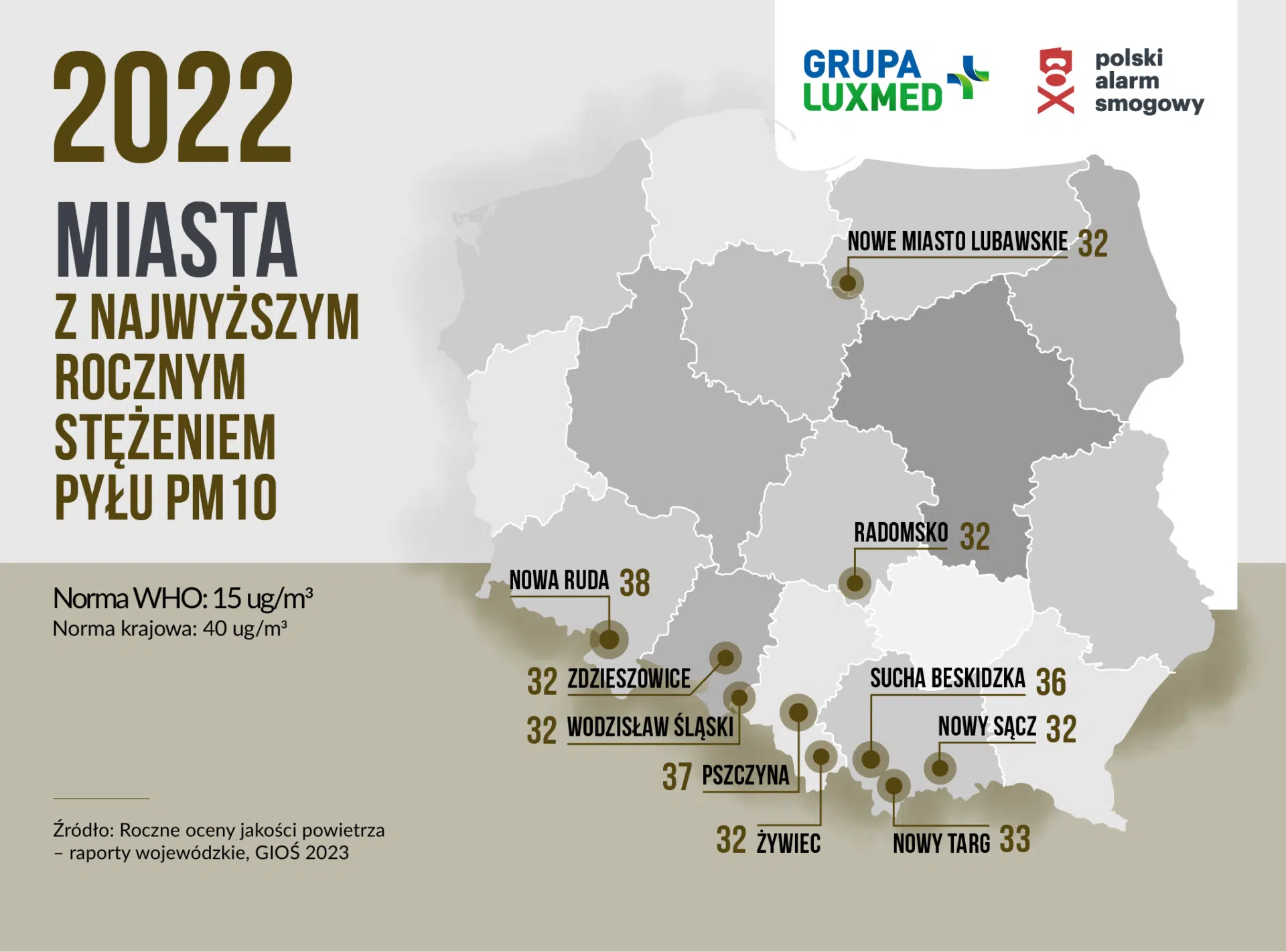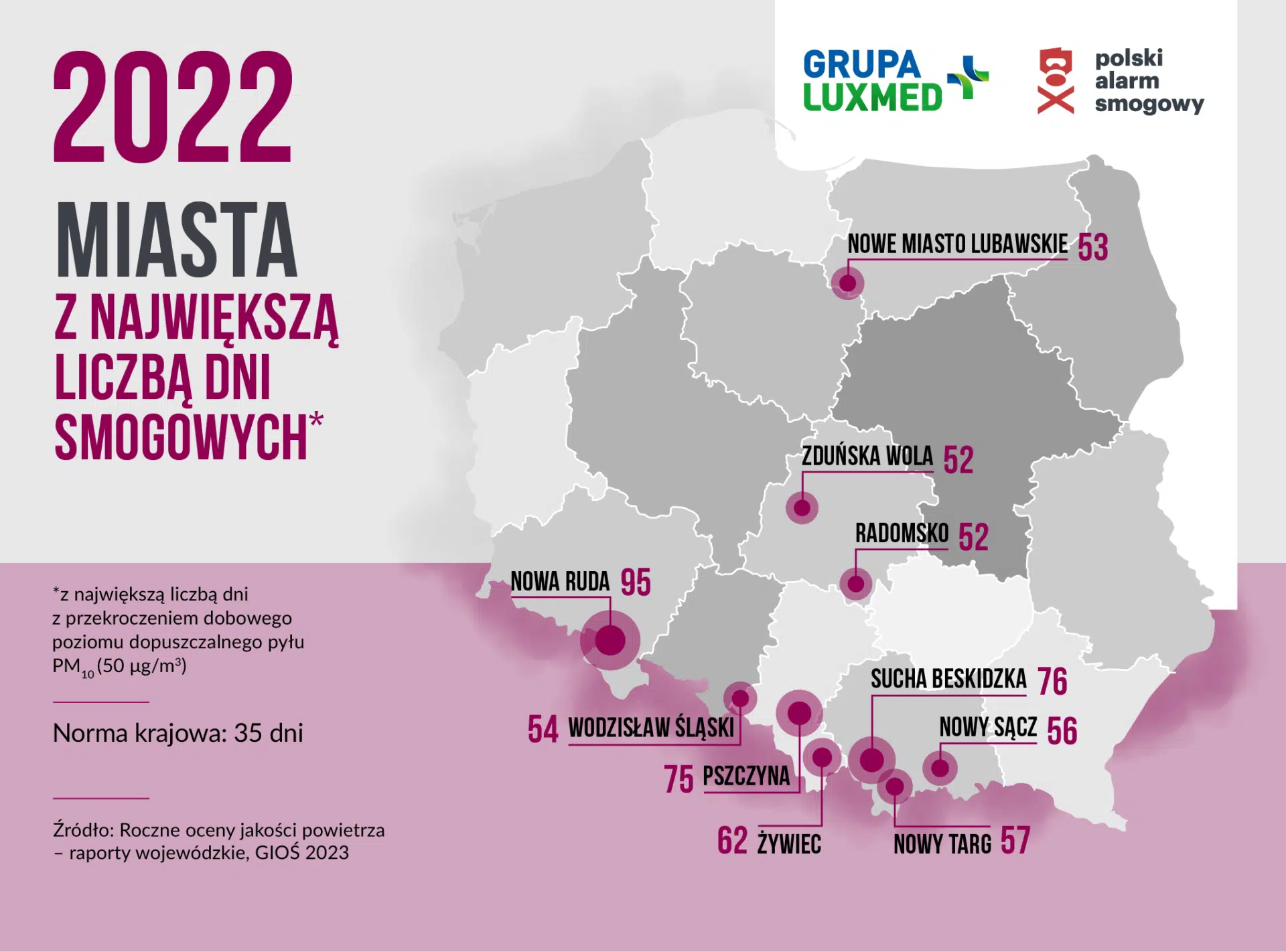An annual “smog ranking” has found that Poland’s air – which is among the most polluted in Europe – has improved significantly. The average annual concentration of one type of harmful air-borne particles was within maximum safe limits in all monitored places for the first time since 2015.
“These are good signs from a still-smoggy Poland,” says Piotr Siergiej, spokesman of Polish Smog Alarm, the NGO that produced the annual report, which is based on 2022 data from the Chief Inspectorate of Environmental Protection (GIOŚ).
A Polish city has the EU's worst air while a further four places in Poland occupy spots among the bloc's ten most polluted in a new ranking by @EUEnvironment https://t.co/hh6sPVuabs
— Notes from Poland 🇵🇱 (@notesfrompoland) June 17, 2021
Smog Alarm’s ranking takes account of three categories: annual average concentration of benzo(a)pyrene (BaP) and small particulates known as PM10s – both of which have adverse health effects – and the number of days in the year during which air pollution levels exceed official safety limits.
Regarding PM10s, the maximum safe limit for their annual average concentrations is 40 micrograms/m3. The place in Poland with the highest figure was Nowa Ruda – a small town in Lower Silesia that also topped last year’s ranking – where the annual average concentration reached 38 micrograms/m3.

Towns with the highest annual average levels of PM10s (source: Polish Smog Alarm)
That marked a decrease of 47% over the last nine years. Similar falls were recorded in other cities that have some of Poland’s worst air, with Kraków and Rybnik seeing PM10 levels decrease by 40% over that period.
When it comes to the number of smoggy days, among the worst ten places the average figure in the latest ranking was 63.2, which represents a 22% decline from last year’s average of 80.9.

Towns with the highest annual number of days during which air pollution levels exceeded maximum safe levels (source: Polish Smog Alarm)
Siergiej pointed to the declining use of coal heating stoves – known colloquially in Polish as kopciuchy – as a factor. Last year, over 35% of Polish households were estimated to use coal for heating, and this has long been seen as a primary cause of Poland’s air pollution.
However, since 2018 the government’s “Clear Air” programme has sought to help households replace old heaters with more modern, cleaner alternatives, as well as to improve insulation. Some places, including Kraków and Warsaw, Poland’s two largest cities, have also moved to ban the use of coal in heating.
“We can see that the implemented actions, especially the elimination of kopciuchy, are starting to bring results,” said Siergiej. “However, it is extremely important that government and local government authorities do not rest on their laurels and continue these activities.”
The quality of air in Kraków has improved considerably since 2012, according to a new study.
Kraków has long had some of the worst smog in Poland, which itself has the EU's most polluted air. But the city has taken a number of steps to tackle the problem https://t.co/0ipu3JwgE0
— Notes from Poland 🇵🇱 (@notesfrompoland) January 28, 2021
He noted that in Nowa Ruda, the concentration of carcinogenic benzo(a)pyrene is still 900% of the permissible level, while in many other places – such as Nowy Targ, Nowy Sącz, Wadowice, Rynik and Żywiec – it is 600% or 700% of permitted safe levels.
Polish Smog Alarm also warns that many towns famous for their “sanatoriums” – places where people, especially the elderly, are sent to recover their health – have harmful air. Szczawnica, Szczawno-Zdrój, Rabka-Zdrój and Jedlina-Zdrój all had BaP levels of 300% to 600% of the safe limit.
“The air is slowly improving and the number of deaths caused by pollution is also decreasing, but the situation is still very bad,” said Smog Alarm’s spokesman. “The continuation and even acceleration of anti-smog measures is key to improving air quality in our country”.
Air pollution is estimated to cause 50,000 premature deaths annually in Poland, as well as a range of other health problems.
A court has ordered Poland to pay a man 30,000 zloty compensation after finding that air pollution violated his rights.
He hopes it will encourage the authorities to deal more seriously with Poland's air pollution, which is among the worst in the EU https://t.co/YWlKwunmRu
— Notes from Poland 🇵🇱 (@notesfrompoland) December 10, 2021

Notes from Poland is run by a small editorial team and published by an independent, non-profit foundation that is funded through donations from our readers. We cannot do what we do without your support.
Main image credit: Jar.ciurus/Wikimedia Commons (under CC BY-SA 3.0 PL)

Agata Pyka is a former assistant editor at Notes from Poland. She specialises in Central and Eastern European affairs, cybersecurity, and investigative reporting. She holds a master’s degree in political communication from the University of Amsterdam, and her work has appeared in Euractiv, the Balkan Investigative Reporting Network (BIRN), and The European Correspondent, among others.



















